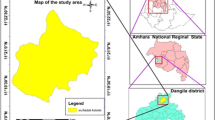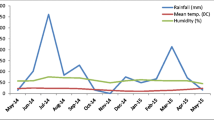Abstract
Acacia nilotica (L.) Willd. ex Del is an important multipurpose tree of traditional agroforestry system in the central belt of the Indian sub-continent. The tree is reported to reduce crop yields under its canopy. However, information is lacking on the spatial variation in soil physical characters, nutrient pool sizes and their availability to crops under its canopy. The present study reports influence of three tree canopy positions, viz. mid canopy, canopy edge and canopy gap, of Acacia nilotica (≥ 12 years) on texture, organic C, total and mineral N and P, and soil pH, in 0 to 10, 10 to 20 and 20 to 30 cm depth of the soil at ten sites in a traditional agroforestry system. Sand particles declined by 10% and 9% whereas clay particles increased by 14% and 10% under mid canopy and canopy edge, respectively, compared to that under canopy gap. Clay particles did not decline significantly with soil depth under all canopy positions. Proportion of silt particles was not influenced by the canopy position. Soil organic C, total N, total P, mineral N (NO3−-N and NH4+-N) and P were greater under mid canopy and canopy edge positions compared to canopy gap. Soil organic C and N pool sizes were maximum in 0 to 10 cm and declined with the depth of soil. Total and mineral P contents were nearly uniform across the depths. C/N ratio tended to increase with the soil depth whereas C/P ratio declined.
Similar content being viewed by others
References
Browaldh M (1995) The influence of trees on nitrogen dynamics in an agrisilvicultural system in Sweden. Agrofor Syst 30: 301–313
Kunc F and Stotzky G (1980) Acceleration by montmorillonite of nitrification in soil. Folm Microbiology 25: 106–125
Lal R (1989) Agroforestry systems and soil surface management of a tropical alfisol. II. Water runoff, soil erosion, and nutrient loss. Agrofor Syst 8: 97–111
Lee D, Han XG and Jordan CF (1990) Soil phosphorus fractions, aluminium, and water retention as affected by microbial activity in an ultisol. Plant and Soil 121: 125–136
Mann HS and Saxena SK (eds) (1980) Khejri (Prosopis cineraria) in the Indian Desert. CAZRI Monograph No. 11, Jodhpur. Central Arid Zone Research Institute. Mimeo 77 pp
Mazzarino MJ, Oliva L, Nunez A, Nunez G and Buffa E (1991) Nitrogen mineralization and soil fertility in the dry Chaco ecosystem (Argentina). Soil Sci Soc Am J 55: 515–522
Nair PKR (1993) An Introduction to Agroforestry. Kluwer Academic Publishers, Dordrecht, The Netherlands, 499 pp
Ntayombya P (1993) Effects of black locust on productivity and nitrogen nutrition of intercropped barley: agroforestry's role in sustainable land-use system. PhD Thesis, University of Guelph, Guelph, Ontario, Canada
Palm CA (1995) Contribution of agroforestry trees to nutrient requirements of intercropped plants. Agrofor Syst 30: 105–124
Pandey AN, Purohit RC and Rokad MV (1995) Soil aggregates and stabilization of sand dunes in the Thar desert of India. Environ Conser 22: 69–71
Pandey CB, Pandya KS, Pandey D and Sharma RB (1998) Growth and productivity of rice (Oryza sativa) as affected by Acacia nilotica in a traditional agroforestry system. Trop Ecol (in press)
Puri S, Singh S and Kumar A (1994) Growth and productivity of crops in association with an Acacia nilotica tree belt. J Arid Environ 27: 37–48
Singh A, Jha AK and Singh JS (1997) Influence of a developing tree canopy on the yield of Pennisetum pedicellatum sown on a mine spoil. J Veg Sci 8: 537–540
Singh JS, Raghubanshi AS, Singh RS and Srivastava SC (1989) Microbial biomass acts as a source of plant nutrients in dry tropical forest and savanna. Nature (London) 338: 499–500
Singh S and Singh JS (1995) Microbial biomass associated with water-stable aggregates in forest, savanna and cropland soils of a seasonally dry tropical region, India. Soil Biol Biochem 27(8): 1027–1033
Singh S and Singh JS (1996) Water-stable aggregates and associated organic matter in forest, savanna, and cropland soils of a seasonally dry tropical region, India. Biol Fertil Soils 22: 76–82
Sparling GP, Whale KN and Ramsay AJ (1985) Quantifying the contribution from the soil microbial biomass to the extractable P levels of fresh and air dried soils. Aust J Soil Res 23: 613–621
Wetzel RG and Likens GE (1979) Limnological Analysis. Saunders, Philadelphia
Young A (1989) Agroforestry for Soil Conservation. CAB International, Wallingford, and International Council for Research in Agroforestry, Nairobi, 276 pp
Author information
Authors and Affiliations
Rights and permissions
About this article
Cite this article
Pandey, C., Singh, A. & Sharma, D. Soil properties under Acacia nilotica trees in a traditional agroforestry system in central India. Agroforestry Systems 49, 53–61 (2000). https://doi.org/10.1023/A:1006314411454
Issue Date:
DOI: https://doi.org/10.1023/A:1006314411454




